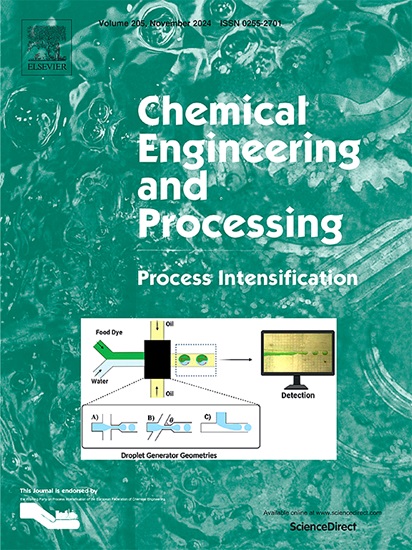A novel ethyl acetate synthesis process with low energy consumption: Simulation optimization and experimental verification
IF 3.8
3区 工程技术
Q3 ENERGY & FUELS
Chemical Engineering and Processing - Process Intensification
Pub Date : 2025-01-31
DOI:10.1016/j.cep.2025.110199
引用次数: 0
Abstract
In response to the problem of high energy consumption in the synthesis of ethyl acetate using excess ethanol, we propose novel low-energy technology for synthesizing ethyl acetate using a considerable excess of acetic acid which saves 80 % energy. Extreme excess of acetic acid ensures the complete conversion of ethanol. The main component at the top of reaction distillation column is only the azeotrope of ethyl acetate and water, which can be easily separated via direct stratification. This process was systematically investigated by combining experiments and simulations. The process simulation is conducted based on the kinetic equation obtained by experiments. The effects of excess acetic acid, liquid holdup in the reboiler, number of theoretical plates, and reflux ratio on product distribution and energy consumption of the reaction distillation column were studied. Furthermore, the main process parameters of the ester purification column and the water-treatment column were optimized. The simulation results were well validated by pilot-scale experiments. Using three distillation columns and under the optimized conditions, the proposed process with a 15-fold excess of acetic acid, and using molecular sieve membrane for water removal from ester, an ethyl acetate purity of 99.999 wt% was achieved with a total energy consumption of 1120 kJ/kg.

求助全文
约1分钟内获得全文
求助全文
来源期刊
CiteScore
7.80
自引率
9.30%
发文量
408
审稿时长
49 days
期刊介绍:
Chemical Engineering and Processing: Process Intensification is intended for practicing researchers in industry and academia, working in the field of Process Engineering and related to the subject of Process Intensification.Articles published in the Journal demonstrate how novel discoveries, developments and theories in the field of Process Engineering and in particular Process Intensification may be used for analysis and design of innovative equipment and processing methods with substantially improved sustainability, efficiency and environmental performance.

 求助内容:
求助内容: 应助结果提醒方式:
应助结果提醒方式:


